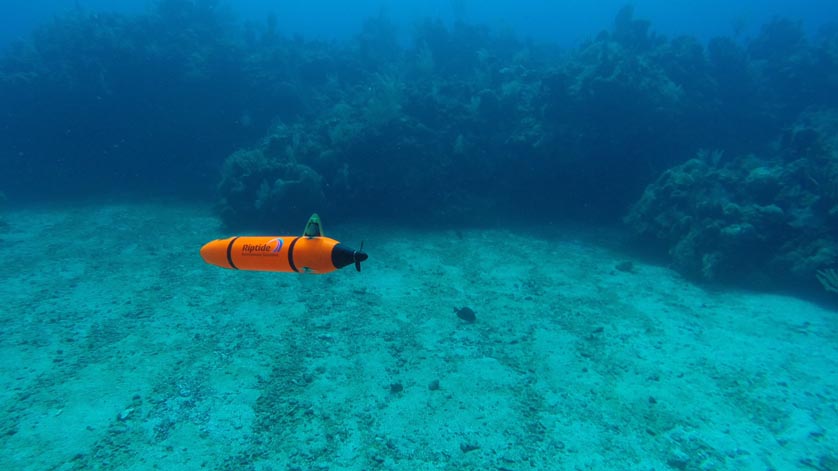May Editorial Focus - Riptide Autonomous Solutions

Development Of A Family Of Flexible UUV
Micro-UUV Technology is Flexible and Fast
In 2015, several veterans of the conventional Unmanned Undersea Vehicle (UUV) sector set out to change the dynamics of the industry, founding Riptide Autonomous Solutions. Riptide's first product was the micro-UUV, a new, highly flexible, open-source autonomous undersea vehicle that provides a state-of-the-art, low-cost solution ideally suited for developers of autonomy and behaviors, power systems, subsea sensors, and other new payloads. The micro-UUV features open hardware and software interfaces, giving users a reliable and robust platform to advance technology development. The vehicle design is optimized for high efficiency, with the best hydrodynamic signature in its class. The base micro-UUV is 4 . In. In diameter, 40 in. In length, and weighs 22 lb. The standard system is rated to a depth of 300 m.

A micro-UUV. The antenna is embedded in the fin for improved hydrodynamics.
Riptide's micro-UUV features three individually actuated control fins providing active roll stabilization. An active GPS antenna, WiFi communications, and vehicle recovery strobe LEDs are integrated into the vertical control fin, reducing the vehicle's hydrodynamic signature for maximum efficiency. Its open system design allows for easy user modification and customization, making this an ideal platform for a wide variety of development needs. Multiple energy source options allow maximum flexibility for endurance, safety, shipping, and mission optimization.
In contrast to typical proprietary architectures, the micro- UUV features a flexible software architecture leveraging a large amount of open-source software. The goal is to foster an active and vibrant user community who will be provided with source code under a standard opensource license. The micro-UUV architecture maximizes the use of existing open-source software, both to provide a mature platform and to tap into existing energetic user communities. In the initial release of micro-UUV software, Riptide is providing code for the Arduino and Beaglebone Black development platforms as well as support for the MOOS-IvP robot control engine. Future releases are planned to include support for ROS (the Robot Operating System) and streamlined user interfaces.
In addition to embracing current software development trends, the micro-UUV has been developed using a large quantity of 3D printing, which enabled affordable and quick evaluation of numerous design considerations. This rapid manufacturing capability has also enabled Riptide to quickly field production vehicles. This approach is not just for engineering the models—products capable of withstanding the pressures and harsh environment of UUV operations are also being produced this way. The use of modern design and manufacturing techniques has also enabled the development and delivery of numerous micro-UUV configurations. A variety of sensors, as well as wet and dry payload bays, have been rapidly developed and successfully delivered—and all within 15 months of the first conceptualization of the product.
Reducing Expense, Easing Logistics
This new generation of micro-UUVs has drawn on the successes and failures of earlier generations that were large, expensive, logistically cumbersome, and limited in endurance. Drawing on these experiences, UUV developers have evolved vehicle designs that optimize configuration flexibility and utilize rapid manufacturing capabilities to minimize the cost of the vehicle. In fact, given its entry price point of $10,000, the micro-UUV could, in certain applications, be considered expendable and abandoned after completion of the mission.
Earlier generation UUVs reflected the constraints of the requirements, technologies, and environment that fostered their creation. Costs were often based on the need to get the job done the best way possible. Once designed, manufactured, and sold, there was little incentive to reduce the costs. Consequently, a clean departure from earlier UUVs was required to make vehicles more conducive to low-cost manufacture and sale. It is this class of vehicle that has overcome the “expense” limitation and brought to market a step change in logistics that now makes new applications feasible.
Increasing Endurance
Full consideration of the drag/power/endurance relationship along with extensive hydrodynamic computer modeling can produce minimum hull drag and optimize fluid flow for extended endurance. In addition, the use of low-power electronic design permits optimization of propulsion and hotel power loads for minimum power consumption. What this means is that the micro-UUV can operate up to 48 hours at 2 knots on a battery comprised of AA alkaline cells. These endurance figures are quoted without a payload because endurance will be payload specific and endurance without payload provides a metric for direct comparison of vehicle capabilities. A sensor payload will reduce the overall endurance, depending on power requirements.
Batteries utilizing Lithium chemistry have improved endurance. Yet, even the capacity of these advanced chemistry batteries has provided limited improvements in the overall endurance of the UUV field while introducing safety and handling issues aboard ships prior to UUV launch.
Through the use of advanced power source technologies such as the aluminum seawater battery from Open Water Power, the Riptide micro-UUV has the capability to operate for over 500 hours at 2 knots (without payloads), enabling significant range and time on mission.
Riptide has an exclusive agreement with Open Water Power for use of their aluminum seawater battery in micro- UUVs and anticipates fielding the initial installation in late 2017.
Expanding the Family
Building upon the successful micro-UUV, two new vehicles have been developed. The new 1-Man and 2-Man Portable UUVs use the same technical architecture, proven hydrodynamic hull shape, and high-efficiency electronics as the original micro-UUV. Drawing upon advanced manufacturing, modern electronics, and open-source concepts, these larger vehicles will deliver the same flexible solution already favored by Micro-UUV users. The 1-Man Portable UUV offers a 7.5 in. (19 cm) diameter and base weight just over 60 lb (27 kg) with a depth rating of 300 m. The 2-Man Portable UUV has a 9.375 in. (24 cm) diameter and a base weight of roughly 120 lb (55 kg) with a depth rating of 600 m.
These new form factors will support new payloads and expanded mission possibilities. Introduced in April 2017, the expanded family of Riptide UUVs will enable new approaches to undersea operations.

